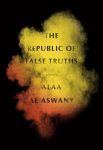 The Republic of False Truths
The Republic of False Truths
Alaa Al Aswany / S. R. Fellowes
Vintage
Beginning on the eve of the Tahrir Square uprising during Egypt’s winter 2011, The Republic of False Truths relates a Dickensian tale of the events from the points of view of members of all societal levels, men and women, Muslims and Copts, orally and in writing, for and against the uprising, and those who must be shocked into choosing sides from their positions of cynical ironic distance. For all the novel’s characters, religious ideals form the basis for the rationales of their moral decisions. At stake is the significant difference between the letter and the spirit of the law, the former prone to opportunistic hypocrisy and corruption, the latter open to discussion and collaboration.
Ten years on and it’s clear that politically, things are back to the Mubarak status quo. The Republic of False Truths suggests that options for the Tahrir revolutionaries are exile, vengeance, or apathy. The book is filled with hope, despite the atrocities committed by the Egyptian government against its own people, and anger—aimed as much at the apathetic Egyptian majority as at Mubarak’s regime. Those who stay and those who remain have equally compelling reasons for their actions, and no easy answer to expelling the systemic rot that leaves so many of Aswany’s protagonists anguished.
 The Passenger
The Passenger
Ulrich Alexander Boschwitz (Philip Boehm, trans.)
Metropolitan Books
Begun the day after Kristalnacht and finished four weeks later, The Passenger is both an impassioned response to Germany’s assault on its Jewish citizens and a prescient observation on what was to come, following the Nazi government’s agenda to its logical conclusion, well before it was implemented with ruthless efficiency.
The novel’s protagonist, Otto Silberman, is a well-to-do tradesman married to a Christian, living a secular life. Adding to Silberman’s good fortune at the novel’s outset is his lack of physical traits seen as stereotypically Jewish. But as the book begins, his negotiations quickly go south with a man he has worked with before, but for whom the current nationwide hostilities toward Jews has encouraged to negotiate in terms of pfennigs on the mark. That deal is interrupted when the police arrive, and Otto is forced to go on the lam out the back door.
Separated from his family (his son lives in Paris, his wife escapes to live with her Nazi brother), Otto spends most of the book (in ominous prescience) travelling around Germany on trains for three days, looking for a way out of the country, only to find closed off every avenue of escape. While his trip shows him that not every non-Jew is complacent with the Nazi regime, he quickly discovers even in himself an abhorrence toward fellow Jews who now suddenly seem obvious, drawing attention to themselves, and clingy. (See Cynthia Ozick’s The Shawl, written decades later, about this.)
Without money, exhausted from his non-stop travels, lack of sleep and decent food, Silberman tries suicide by cop without success. For that, he will need the help of his fellow Germans.
 Motley Stones
Motley Stones
Adlabert Stifter / Isabel Fargo Cole
NYRB Classics
The narrators of these stories—the motley stones—are several generations removed from their tales, provided as descriptions of persons of remarkable character. Written in the mid-1800s, Stifter’s tales occur probably around the turn of the 18th century, when Germanic nations were primarily rural, and even the biggest cities were modestly sized by today’s standards. Although the natural world is lavishly described throughout, with eyes and insight worthy of Thoreau, Stifter is primarily interested in inflexible eccentricities. Stifter’s narrators clearly admire these people while also acknowledging that some readers may find them mere fools, while others—like the narrators—are marked for life by the encounters.
One such example is the nameless, ascetic parson in the story “Limestone.” (Spoiler alert!) The parson has a secret cause he’s been stowing away money for—to build, for safety reasons, a new school for the local children. For decades he scrimps and sacrifices, living just above beggary level. Late in the story, after he dies and his will is read, his bequest to the community is revealed—as is the fact that his 30+ years of savings isn’t nearly enough to cover costs. The well-to-do in the area rise to the occasion and raise the funds necessary to fulfill the requirements of the parson’s will.
Stifter does, or did, have his detractors for his attention to small people of small significance. And I can imagine them saying about “Limestone,” “Good lord. Generations of parents risked their children drowning to reach school during deluges on the floodplain. And even though the area had been settled for centuries, it wasn’t until an outsider to the community—the parson—noticed a much safer location for the school already existed—but he didn’t say a word about it until after his death. Who are these people?”
But it’s Stifter’s attention to minutiae that makes his writing fascinating, so that 50-page story about a boy punished for walking in the house with greased feet becomes a compelling meditation on geography, landscape, history, and human relationships in small communities. Even if we don’t understand a character’s motivation (Why does a cuckolded husband take his daughter and leave a community after his wife has run away? Why does he resign them to a life of poverty, living in the basement of a dilapidated apartment building?), the reactions these characters elicit in the other characters often brings out the best in human compassion. Stifter may be an idealist—not for acting as if the world is nothing but pureness and light—but for insisting there is more inherent good than evil in the world, and that goodness eventually irons out the bad.

X-Risk: How Humanity Discovered Its Own Extinction
Thomas Moynihan
Urbanomic
A fascinating, wide-ranging intellectual history of an idea whose consequences we’re just beginning to grapple with, X-Risk traces the history of how humanity became self-conscious of its ability to bring the planet’s biota to the point of the extinction, a history beginning with the sense of humanity’s own ending via apocalypse or extinction.
While apocalypse is spiritual, moral, and God-determined; extinction is material, amoral, and human-determined. In apocalypse only the evil suffer; in extinction, everybody suffers. The apocalyptic asserts an entire cosmos structured according to moral principles and truths, populated by Earth-like creatures, including and especially humanoids. Extinction asserts through evidence that as conscious, technologically savvy beings, we are alone in the universe, have only one chance on Earth, and are likely to die out sooner or later, no matter what we do.
As material evidence about the Earth’s lands and seas accumulated over the course of 150 years or so, the religious assumption that human-like life populated the Earth’s oceans and core (and by extension the entire universe) was replaced by the fact that it’s mostly inorganic matter all the way down. As measured in sentient life, God’s abundance and goodness were shown to be in short supply.
Furthermore, once the ability to age rocks arose and knowledge acquired of the materials and forces required of their formation, geologists could then demonstrate the existence of a vast, “deep time” in the past—but a past with a moment of origin rather than one that has eternally existed, as had been believed.
Discontinuities among fossils with contemporary fauna also demonstrated that extinction of entire species had occurred in the past and will likely occur in the future. Reports coming from the New World during the 18th- and 19th-centuries indicated that humans were also currently hunting to extinction native birds and mammals.
Theological assumptions of eternal cycles of death and renewal, of eternal plentitude everywhere, had been cut at both ends, past and future. Replacing a sense of eternal plentitude was the realization that everything is on a one-way trip to oblivion.
Once the fact of a changing but a-cyclical material history was established among sciences from biology to geology, the discovery in mathematics of calculus and the establishment of probability theory allowed the prediction of future events. At one point in human development, deviations from daily norms were interpreted as unpredictable acts of God (or the Devil). But now, physical forces of change—past and future, planetary and cosmic—could be determined and the mechanisms behind deviations explained and predicted.
Debates within the sciences, and the physical records they were based upon, were mediated by various philosophers, British Romantic poets, and prescient French novelists, who also all began predicting what the future holds in store for humanity (something unhappy) and why and how (or if) that direction should be changed.
But notions of “better future” indicate that, if minimizing human misery is the goal of technology and ideological systems, then not being born would be in the best interests of all people. Once the likelihood of humanity’s extinction was established and the misery of human existence universally acknowledged, proposals for omnicide began popping up in philosophy and the sciences. Some omniciders argue for accelerating the natural course of human extinction, rationalized as doing the universe a favor, arguments earnestly presented by anti-natalists as an overall moral good. Moynihan is not one of their supporters.
Nor does he endorse a future in which humans evolve toward some form of drug-induced pleasure-stupor, coddled by technology designed to perpetuate our existence.
Insofar as we have any Lamarckian abilities to steer the course of our otherwise Darwinian (aka aimless) evolution, Moynihan argues that we should aim to live above mere survival level that happy droolers inhabit and equip ourselves with a life vocation: Once the bare minimum to survive has been satisfied, our remaining physical and mental efforts should be used toward achieving perfection in some skill.
Or if achieving, say, Olympic-contender greatness isn’t among the skills a person wants to develop, they can work instead to use technology to devise ways to help humans live with and correct the world-wide ecological disaster currently unfolding. Unlike other species, Moynihan argues, we have the ability and should do what we can to sustain and perpetuate ourselves, and as much other life as we can, too.
While I would counter that every well-engineered solution is also a well-engineered problem, correcting our path as we go along may be our only chance for longer survival, even if every solution proves temporary, creating new problems in its wake.
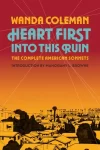 Heart First into This Ruin: The Complete American Sonnets
Heart First into This Ruin: The Complete American Sonnets
Wanda Coleman
Black Sparrow Press
Originally published in sections across various of her poetry collections, Heart First into This Ruin finally collects into one volume the complete 100 American Sonnets, Coleman’s contribution to the sonnet form and the aesthetic expression of her experiences as a Black woman in America, un-degreed and unmarried—experiences simultaneously singular and familiar, unique and shared, compressed to 14 lines (the only formal element her sonnets share with traditional sonnets). The lines and stanza lengths vary from poem to poem, suggesting that Coleman tries to tailor each poem’s meter to its subject, the way it is talked about, described. And this she does very well, covering family, erotic love, work, chronic poverty, racism, and the damned knowledge that she is better than what she receives from American society.
Here’s Coleman in meditative form, “American Sonnet #76”:
there be the fog outside and the fog inside
settling over the gravesites and skin
climate fit for ghosts and amnesiacs, befogged,
intrusive skirtings thru filters, cracks
and secret spots, mist forming at my lover’s
kiss in the pretty air, the kiss hovering and diving
before it strikes me. mist oceanflow from resistance to
peace time, mist taking root in the brown chair at the
pine desk, composing, there is internal fog and external
fog. a garden of spirits and drums, sprites
thrilling on the ooze, of firs, walking naked, cold and
hungry for smoke, the east, want borne on wickedness like
a shot, or kiss, before diving into blankets and history
to embrace the fog to give it form and flesh
An essential collection of American poetry from the late 20th century.
 Air Raid
Air Raid
Polina Barskova /Valzhyna Mort
Ugly Duckling Presse
The poems of Air Raid are often built upon phrases found in documents made available to researchers after the Soviet Union’s collapse. Letters, notes, and other ephemera written either during the time of Stalinist purges or during the near 900-day siege of Leningrad. Other poems are based on archival materials from collections outside Russia.
The prelude to the poems that make up “Air Raid” imagines apartment residents congregating when the mail arrives, only to find the following marks on their letters:
Postmark:
“returned mail” “urn mail” urrrrrrrr
“doesn’t reside at this address” doesn’t doesn’t this
“unable to deliver”
DE
FRANKLY SPEAKING I’M WORRIED ABOUT YOUR SILENCE
Already 10 hours
Already 10 years
Already years your silence worries me
Although this poem ostensibly concerns the siege of Leningrad, would any part of it change if the topic were victims of Stalin’s purges? Whether by their own government or by Nazi forces, Soviet citizens were targets of deliberate annihilation. Here is a response to Nazi atrocities from the point of view of a Polish Jew, “Aladdin,” a poem in the cycle “Hampshire College Archive. Personae.”
A blackened milk tin
contains a letter of Israel Lichtenstein
written in the year of 1942 obviously.
Naturally, in the Warsaw Ghetto
two weeks before his departure to Treblinka.
Naturally.
The letter reads:
I accept oblivion for myself and my loved ones.
(My wife, whose name here is meaningless,
leave her here now nameless and faceless)
ready to become pearl string of teeth,
a chestnut lock in a mattress, a shadow.
Yet, we really wish
that whoever finds this letter inside a milk tin
resembles our daughter—Margalit.
Today, she turns twenty months.
O, she’s an extraordinary child!
Let me tell you, what a little talker, our Margalit!
Whether Barskova bases her poems on archival material or writes from creative empathy, she discovers places of hopeful persistence and joy, with love as the propelling force.
Bi-lingual edition with a lengthy interview of Barskova by translator Valzhyna Mort.
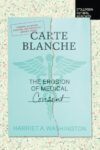 Carte Blanche: The Erosion of Medical Consent
Carte Blanche: The Erosion of Medical Consent
Harriet A. Washington
Columbia Global Reports
Harriet A. Washington is a researcher and reporter of medical malfeasance whose work has received recognition and awards from the National Book Critics Circle Award, the PEN Oakland Award, and the American Library Association Black Caucus Nonfiction Award, and who lectures at Columbia University. The subtitle of Carte Blanche contradicts Washington’s argument; namely, that medical consent was only ever a thing after its violation: So, for instance, while Nazi doctors were rightfully tried at Nuremberg for crimes against humanity by forcing medical experiments upon unwilling participants, lawyers for the doctors’ defense noted that non-consensual medical experiments of the most horrific nature were routinely practiced by the medical establishment of the prosecuting nations—the hypocrisy was as unappreciated as it was falsely self-righteous. So, while “medical consent” is the ethical standard within the U.S., good luck having it granted to you if you are a person of color.
As Washington shows, non-consensual medical experimentation never ended with Tuskegee, and it continues to this day in cities where Black populations are significantly high. In fact, with a population 86% Black, Detroit makes an ideal hub for non-consensual research (housed at Wayne State University), including injections of synthetic blood offering high rates of mortality and harm to various organs and neural pathways. Coercion and refusal to disclose what has already happened are also means of obtaining non-consent, and Blacks in the military (men and women) and prison are also targeted far more than their white counterparts. They are forced to make sacrifices that will most benefit those who least look like them.
Washington documents how these egregious ethical abuses are possible, the legal loopholes that exist created specifically to avoid consent, the for-profit (!) institutional review boards that rubberstamp approvals for coercive practices, and potential solutions to these problems. Carte Blanche is as important as its revelations are awful.
 The Devils
The Devils
New Juche
Amphetamine Sulfate
Taking place in Scotland, where New Juche grew up during the ‘80s but connecting his time in Newbattle with its history of torture and murder and the rape and murder in 2003 of a 15-year-old girl in a house close to where he once lived. The argument behind New Juche’s The Devils is that neighborhoods like the one he grew up in are breeding grounds for such atrocities. More to the point, he implies that crime, casual violence (domestic and public), routine drug and alcohol abuse—let alone torture and murder—are inherent to the historical place of Newbattle.
 Grey Bees
Grey Bees
Andrey Kurkov / Boris Dralyuk
Deep Vellum
Taking place roughly about now, Sergey Sergeyich lives by himself in a village abandoned by all but one other person—his childhood enemy. The village has been abandoned because of Russia’s war against Ukraine, which it has been waging since 2014, and the two sides have been exchanging mortar bombs at distances roughly equidistant from Sergey’s village, Little Starhorodivka, set in an area known as the “grey zone” that no one controls. Sergey, in his early 50s, receives a disability pension (in a war zone? hah!) for mining-related silicosis but hasn’t left the village because his bees a quiet rural area to thrive in.
Despite the bleak setting, meager food supplies, lack of electricity, unnerving uncertainty of the bombings, and proximity to a life-long “enemy,” Grey Bees is often funny, and Sergey is slowly revealed as the compassionate soul he his. There are literal and metaphorical ways of living in a grey zone, and once he literally leaves Little Starhorodivka to find safer grounds for his bees, both begin to vanish.
Before and along the trip he meets two husbandless households with children, one Christian the other Islamic, befriending the wives. He meets Russians hostile to and suspicious of Ukraine and Tatars (the Muslims). He suddenly finds himself—his very existence—under varying levels of threat. The road novel is probably an American invention, but Andrey Kurkov does well at transplanting the genre to Ukraine, a nation that has its own North and South, its own ethnic and religious hostilities, its own faulty distinctions between police and military powers. The point of the road novel is to discover oneself in the face of fellow citizens. In Grey Bees, proves to Sergey be a man of principle and quiet action, whose simplicity should not be mistaken for naivete but for wisdom arising from watching and listening. Although Sergey is described as specifically Christian and consistently observant, his actions, which—once the patina of fear is brushed away—are based on universal principles of grace and decency, consistently engaged: the “do unto others” credo pretty much every faith has some version of.
Boris Dralyuk’s translation of Grey Bees is excellent, and I strongly recommend it as way into seeing the current conflict from the point of view of those just want to get through life and act as decent people.
 Rouge Street
Rouge Street
Shuang Xuetao / Jeremy Tiang
Metropolitan Books
Over the last decade, chaotic reality had so numbed his brain that he no longer felt much of anything, and he wasn’t inclined to make any major changes that might send his life careening down a perilous road to the mere possibility of hope. —From the novella “The Aeronaut”
Shuang Xuetao’s Rouge Street collects three novellas that take place in China’s Northeast industrial area, an area that had been in decline for decades, but which was revived and its factories updated during the Cultural Revolution (1966-1976), when millions of China’s citizens were “reassigned” or “sent down” to the area to work in China’s inadequate factories as punishment for “bourgeois” thoughts and actions. The rounded-up undesirables included people with college degrees, training, or skills, as well as petty criminals. After the Cultural Revolution, China still needed its factories, and many people stayed after their period of “re-education” ended. Thus, the neighborhoods in which these stories take place are mixtures of people from many backgrounds, from intellectual to criminal, whose thoughts and actions continue to be haunted by the Cultural Revolution.
For instance, in the first story, “The Aeronaut,” the narrator Xuguang thinks over why he has no interest in attending college even though, now that the Cultural Revolution is over and universities are reopening after ten years shut: “if he became a college student, that would make him some kind of professional egghead, and to what end?”
Look at the ten years that had just gone by, and project them forward two decades—would these college students enjoy the fruits of their labors? He’d witnessed a classmate slitting a teacher’s nose, and if he’d wanted, he could have grabbed the knife and slashed that teacher’s cheek as well. They said A one day and B the next, and now the university entrance exams were back, but who could say that they wouldn’t turn from B back to A again? All that studying, only to end up as a stinking ninth-rate intellectual?
Into this hopeless world Xuguang is sent to find his uncle, the one who had first dreamed of designing jet packs for people to travel with, toward which key family members had invested. Even though his dream didn’t come true—an idea unencumbered by any knowledge of physics or design—the family still admires his imagination and ambition. Otherwise, uncle is a homeless drunk.
But compare the desultory life of his Xuguang’s uncle to his mother’s traditional life with his father:
After the factory went bankrupt and the two of them had to fend for themselves, her spirits grew a little heavier. When their home was demolished in the government’s urban clearances, and they had to move to a shantytown on the outskirts of the city, her spirits grew heavier still. They were given a new apartment in compensation, but it never got any sunlight, no one ever cleaned the shared corridors, and the young renters upstairs were professional thugs. Then my father died, a blow that completed Ma’s descent into dour middle age.
As it comes to pass, the uncle has one more trick up his sleeve, this one already assembled and ready to go.
“Bright Hall” concerns the inhabitants of a building on a winding road called Yanfen Street. In one of its incarnations, it was used during the Cultural Revolution for interrogations by Red Guards. The main action of the story takes place some 10 or 15 years afterward, and involves a character who obtains a meticulously detailed map of Yanfen Street from Liao Chenghu, an acquaintance of the narrator’s but 30 years his senior, whose middle fingers were chopped off by Red Guards at Bright Hall because he created sculptures alleged to be reactionary.
As minutely detailed in the map, Yanfen Street’s winding length forms a geographically enormous coil with a lake at its center, a decrepit factory nearby, and a cemetery behind it. The street’s coil is like the circles of Dante’s Inferno, but the characters of “Bright Hall” are unvoluntary inhabitants of a hell perpetuated by government actions designed to undermine civic harmony and encourage the betrayal of friends and family in the name of ideological purity, leading to multi-generational duplicities among family members and friends. Unlike Dante’s Inferno, however, few people on Yanfen Street live there because they “deserve” it, and few seem to understand what they’re caught up in.
“Moses on the Plain” is told via an interconnected set of first-person narratives that explain a community and solve a murder over a 12-year period. The time is Post-Cultural Revolution but before China enters the world market and its manufacturing secture goes into overdrive. Threatened during this time (and continuing today) are old apartment complexes that the government razes while dispersing the former tenants to different cities, their bonds severed, including agreed-upon gestures and gifts that settle arguments and forge modes of mutual reciprocation and responsibility.
Downbeat but realistic, Shuang’s characters are compelling even when misguided, and Jeremy Tiang’s translation is rendered smoothly in idiomatic English.
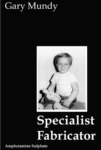 Specialist Fabricator
Specialist Fabricator
Gary Mundy
Amphetamine Sulphate
“Gary Mundy is the founding member of Ramleh, and ran the legendary label Broken Flag,” says the blurb on the Amphetamine Sulphate website, none of the proper nouns in it had I heard of before reading this 40-page book, but which, as a fan of Merzbow, I can now say, OK, I can see all of this happening—whether or not it’s literally or fictionally true. For those who have no idea what I’m talking about, I’m talking about a small niche in contemporary music devoted to making noises via some instruments, yes, but also computers, signal generators and controllers, forms of feedback. Wearing earplugs to these concerts (strongly advised) will not stop your ears from ringing the next two days. The experience is intense. Bringing that intensity to a concentrated bit of roman a clef is what Specialist Fabricator does particularly well.
Specialist Fabricator is (perhaps) Mundy’s autobiographical musings about his beloved father’s death; his battles with profound anxiety and, as a result, drugs and alcohol; and his fears of having betrayed two peers to a bad fate early in life and making his wife’s life a hell by doing such things as attempting suicide in front of her. The narrative is unadorned simplicity, seamlessly weaving together strands of the story occurring years and decades apart from each other. The mad compulsion to suicide forms the climax of the book, which put me in mind of Simon Critchley’s Memory Theatre and Notes on Suicide, which also cover emotionally intense breakdowns with sympathy and insight.
Who cares if the entirety of the story is factual if the story is both well-told and true to life? Mundy engages in cagey maneuvers about how much he’s reporting is fact-based, which I don’t think are necessary given how common it is anymore for authors and protagonists to share the same name and tics.
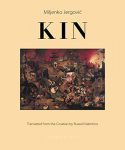 Kin
Kin
Miljenko Jergovic [Russell Scott Valentino, trans.]
Archipelago Books
Kin is a fictionalized account of Miljenko Jergovic’s Serbian / Croatian / Yugoslavian / Christian family history, extending from the early 20th century and working forward—times of national and international tensions, international and civil wars—wars where being a person with the wrong combination of ethnic / religious heritages in the wrong neighborhoods could have fatal consequences. Croatia endured invasion by the Nazis, followed by Soviet oppression, followed by the war in Sarajevo. Not surprisingly, charting the complexities of the past hundred years as endured by just one family living in just one city with its particular Eastern European mix of ethnicities, religions, and political affiliations takes more than 900 pages.
Kin’s web is formed of interconnected and overlapping lives and influences on Jergovic’s extended family, beginning with his strong-willed and stern great-grandfather, Karlo Stubler. Less a novel than a collection of, um, related short stories and novellas about one family’s history in relationship to local and world political geography over the course a century, Kin illustrates how consequences ripple across the generations and along chains of kinship, whether those ripples be formed by actions within the family or imposed upon it by social conditions of the time.
Overshadowing much of the book are Jergovic’s grandparents, Franjo and Olga, as well as his troubled relationship with his mother, who didn’t begin to attempt to raise him until he was 10. Franjo and Olga, however, are a broken couple, split by Olga’s encouragement of their son, Mladen, to enlist in the German army, during WWII, rather than join the resistance because she thought the Nazis would win the war, which would improve Mladen’s odds of living. Franjo was against it, thought Mladen was better off with the resistance, but made no effort to stop his son from by being swayed by Olga. The consequences of that decision haunt the days, years, and decades following Mladen’s death in combat for the German army. This regret in an area where one could point out, several decades later, who among the currently living, unpunished, killed who during the war in Sarajevo.
Over time, as she ages, Jergovic increasingly focuses on his mother—and thus a century’s worth of family dynamics play out across Sarajevo’s unhappy history at the start and end of the 20th century. Jergovic’s relationship to Sarajevo is also ambivalent.
The novel’s last section matches photographs of places and family members, accompanied by a few paragraphs describing what is shown. Most are poignant and sad. The caption to a photograph of one family member encapsulates the novel’s themes and mood particularly well:
The wartime devastation is visible on the face of Home Army First Lieutenant Rudolf Stubler. Eternal polytechnics student in Graz and Vienna, gifted violinist, lover of music, poetry, and mathematics, skilled beekeeper. Women loved him. A delicate soul, sweet and smart, when this picture was taken at the Winterfield Photography Studio, he was twenty-four years old and had not worked a day in his life. . . He had grown thin from fear, as he lay down every evening with taps, turning his back to the sleeping Home Guardsman, and instead of the barracks wall before his face, Rudi found himself face to fac with this own death, who would say: You won’t make it.
When I first wrote this review, Kin has just been longlisted for the 2022 Dublin Literary Award. Congratulations are due to both author Miljenko Jergovic and translator Russell Scott Valentino, the latter whose translation is a gracefully performance.

keep me on your mailing list